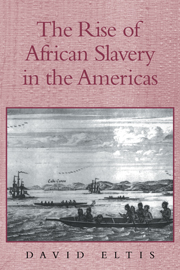Book contents
- Frontmatter
- Contents
- List of Tables
- List of Maps
- Preface
- Abbreviations
- Chapter 1 Slavery and Freedom in the Early Modern World
- Chapter 2 The English, the Dutch, and Transoceanic Migration
- Chapter 3 Europeans and African Slavery in the Americas
- Chapter 4 Gender and Slavery in the Early Modern Atlantic World
- Chapter 5 Productivity in the Slave Trade
- Chapter 6 Africa and Europe in the Early Modern Era
- Chapter 7 The African Impact on the Transatlantic Slave Trade
- Chapter 8 The English Plantation Americas in Comparative Perspective
- Chapter 9 Ethnicity in the Early Modern Atlantic World
- Chapter 10 Europe and the Atlantic Slave Systems
- Epilogue on Abolition
- Appendices
- Maps
- Sources and Bibliography
- Index
Chapter 2 - The English, the Dutch, and Transoceanic Migration
Published online by Cambridge University Press: 05 August 2012
- Frontmatter
- Contents
- List of Tables
- List of Maps
- Preface
- Abbreviations
- Chapter 1 Slavery and Freedom in the Early Modern World
- Chapter 2 The English, the Dutch, and Transoceanic Migration
- Chapter 3 Europeans and African Slavery in the Americas
- Chapter 4 Gender and Slavery in the Early Modern Atlantic World
- Chapter 5 Productivity in the Slave Trade
- Chapter 6 Africa and Europe in the Early Modern Era
- Chapter 7 The African Impact on the Transatlantic Slave Trade
- Chapter 8 The English Plantation Americas in Comparative Perspective
- Chapter 9 Ethnicity in the Early Modern Atlantic World
- Chapter 10 Europe and the Atlantic Slave Systems
- Epilogue on Abolition
- Appendices
- Maps
- Sources and Bibliography
- Index
Summary
The Iberians began the process of imposing a European view of the world on Atlantic regions (specifically of labor) before Columbus, when they began to enslave the Guanches, natives of the Canary Islands. Yet, as argued in Chapter 1, the full development of that view, along with the ability to impose it, occurred in northwest Europe after 1650. The concepts of slavery and freedom, the linking of these concepts with non-Europeans and Europeans, respectively, and the apogee of European power in the prenineteenthcentury world awaited the rise to dominance of the Dutch in Asia and English in the Atlantic. Both the nature of the European world-view as well as the power of its proponents to project it across oceans stemmed ultimately from Europe's view of the relationship of the individual to society. Chapter 1 has argued for important differences between Europe and the rest of the world on this issue, and, within Europe, between England and the Netherlands together and other countries. Chapter 2 examines some of the social structures associated with this Anglo-Dutch view of the world and how these structures affected economic performance in general and transatlantic migration, both free and coerced, in particular.
Thirty years ago Carl Bridenbaugh attributed “the first swarming of the English” to poor social conditions within England. A large social history literature has supported this position or at least testified to a rising incidence of poverty until the mid-seventeenth century.
- Type
- Chapter
- Information
- The Rise of African Slavery in the Americas , pp. 29 - 56Publisher: Cambridge University PressPrint publication year: 1999



